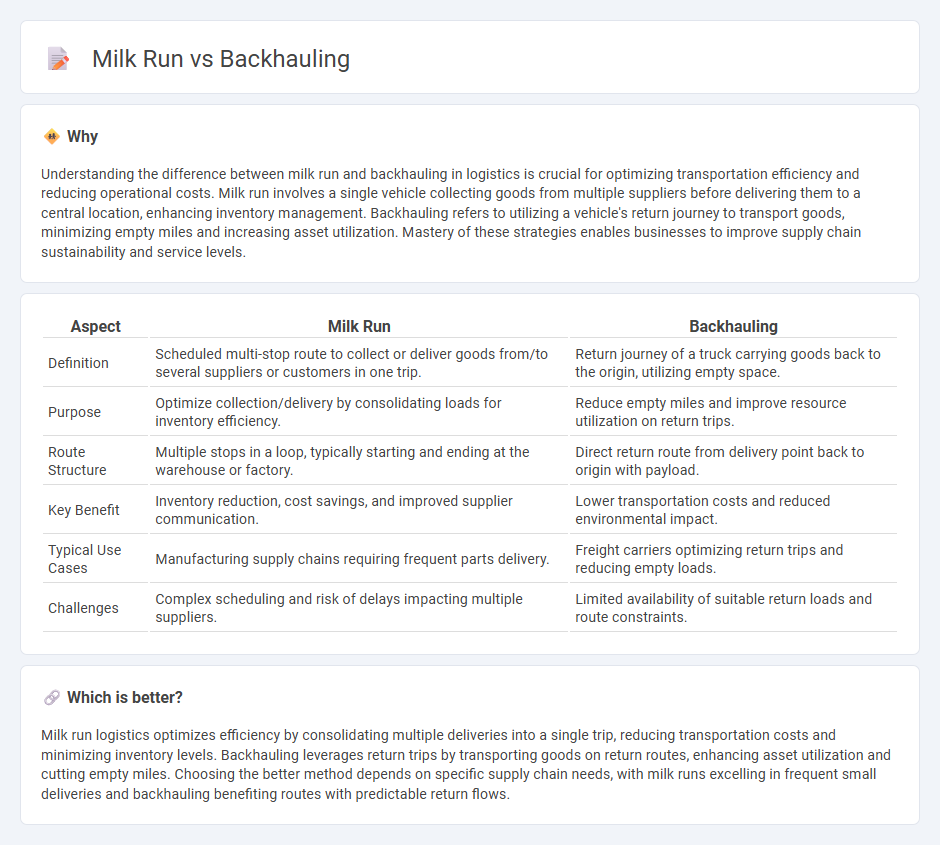
Milk run logistics optimizes supply chain efficiency by consolidating multiple deliveries or pickups along a fixed route, reducing transportation costs and lead times. Backhauling involves utilizing return trips of delivery vehicles to transport goods, minimizing empty miles and increasing overall fleet utilization. Explore how these strategies enhance operational performance and sustainability in logistics.
Why it is important
Understanding the difference between milk run and backhauling in logistics is crucial for optimizing transportation efficiency and reducing operational costs. Milk run involves a single vehicle collecting goods from multiple suppliers before delivering them to a central location, enhancing inventory management. Backhauling refers to utilizing a vehicle's return journey to transport goods, minimizing empty miles and increasing asset utilization. Mastery of these strategies enables businesses to improve supply chain sustainability and service levels.
Comparison Table
| Aspect | Milk Run | Backhauling |
|---|---|---|
| Definition | Scheduled multi-stop route to collect or deliver goods from/to several suppliers or customers in one trip. | Return journey of a truck carrying goods back to the origin, utilizing empty space. |
| Purpose | Optimize collection/delivery by consolidating loads for inventory efficiency. | Reduce empty miles and improve resource utilization on return trips. |
| Route Structure | Multiple stops in a loop, typically starting and ending at the warehouse or factory. | Direct return route from delivery point back to origin with payload. |
| Key Benefit | Inventory reduction, cost savings, and improved supplier communication. | Lower transportation costs and reduced environmental impact. |
| Typical Use Cases | Manufacturing supply chains requiring frequent parts delivery. | Freight carriers optimizing return trips and reducing empty loads. |
| Challenges | Complex scheduling and risk of delays impacting multiple suppliers. | Limited availability of suitable return loads and route constraints. |
Which is better?
Milk run logistics optimizes efficiency by consolidating multiple deliveries into a single trip, reducing transportation costs and minimizing inventory levels. Backhauling leverages return trips by transporting goods on return routes, enhancing asset utilization and cutting empty miles. Choosing the better method depends on specific supply chain needs, with milk runs excelling in frequent small deliveries and backhauling benefiting routes with predictable return flows.
Connection
Milk run and backhauling are closely connected logistics strategies that optimize transportation efficiency by reducing empty return trips. Milk run involves collecting goods from multiple suppliers in a single trip, while backhauling utilizes the return leg of a delivery vehicle to transport goods, minimizing wasted capacity. Combining these methods lowers transportation costs, improves supply chain sustainability, and maximizes vehicle utilization.
Key Terms
Route Optimization
Backhauling maximizes vehicle utilization by carrying return cargo on the route back to the origin, reducing empty miles and transportation costs. Milk run involves multiple pickups or deliveries in one trip along a predetermined route, optimizing stops to increase efficiency and lower logistics expenses. Explore in-depth strategies and tools to enhance route optimization for supply chain efficiency.
Load Consolidation
Load consolidation in backhauling involves transporting full truckloads on return trips to maximize efficiency and reduce empty miles, leveraging existing freight routes. Milk run load consolidation optimizes multiple deliveries or pickups in a single route, enabling partial loads from various suppliers or customers to be consolidated. Explore more to understand which strategy best suits your logistics needs.
Transportation Efficiency
Backhauling optimizes transportation efficiency by utilizing return trips to carry additional cargo, reducing empty miles and lowering fuel costs. Milk run logistics consolidate deliveries or pickups into a single route, maximizing load capacity and minimizing transportation frequency. Explore in-depth strategies on how these methods improve supply chain performance.
Source and External Links
What is backhauling? - Teletrac Navman US - Backhauling in trucking refers to planning roundtrip hauls by transporting goods on every leg of a truck's journey to increase utilization, improve productivity, and reduce fuel consumption.
What Is Backhaul Trucking: Everything You Need To Know - Backhaul trucking is a reverse logistics strategy of hauling loads during a truck's return journey to its origin, reducing unprofitable empty miles and increasing revenue while supporting eco-friendly supply chains.
What is Backhaul? Logistics Glossary - Penske - Backhaul is the practice of returning cargo from the delivery location back to the truck's point of origin to minimize empty miles and reduce operating costs for carriers.
 dowidth.com
dowidth.com